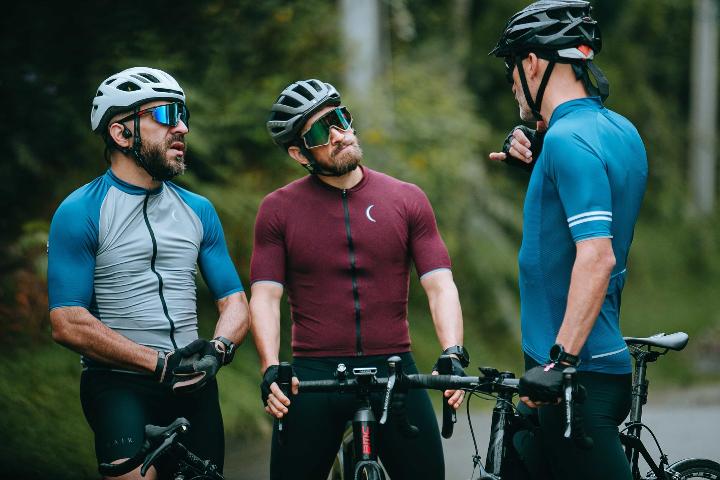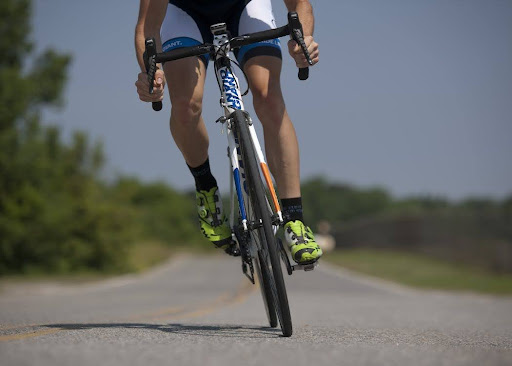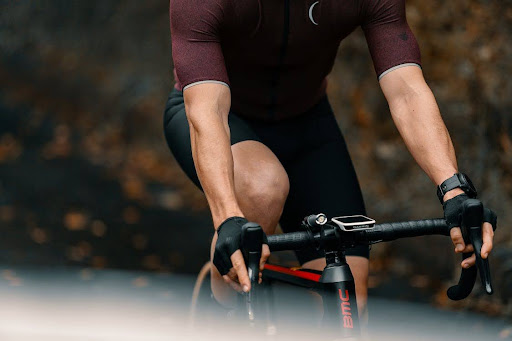What Muscles Does Cycling Work?

As a passionate cyclist, I often wonder about the muscles that are engaged during my cycling workouts. Understanding the specific muscle groups involved can help me optimize my training and achieve better results. So, what muscles does cycling work?
Cycling is a fantastic full-body workout targeting various muscle groups, providing comprehensive strength and endurance training. Let's delve into the muscles used in cycling and how they contribute to our performance.
Key Takeaways:
- Cycling engages a wide range of muscles, including the lower body, core, and even parts of the upper body.
- The primary muscles used in cycling are the quadriceps and glutes, followed by the hip flexors, hamstrings, calf muscles, and shins.
- Supporting muscles, such as the hip abductors and adductors, provide stability to the hips and knees.
- Efficient cycling involves using all of these muscles evenly throughout the entire pedal stroke.
- Proper strength training, warm-up, and recovery routines can optimize your cycling workout.
The Role of Quads and Glutes in Cycling

Regarding cycling, the quadriceps and glutes are crucial in generating power and propelling the bike forward. These leg muscles are the primary drivers of force during the downstroke phase of the pedal stroke, making them essential for efficient cycling.
The quadriceps at the front of the thigh are responsible for extending the knee and straightening the leg. They are the largest muscle group in the legs and are highly activated during cycling. The glutes, which are the muscles in the buttocks, provide additional power and stability. They assist in extending the hip joint and generating force during the pedal stroke.
Effective cycling technique involves engaging and activating both the quadriceps and glutes. This requires evenly distributing the workload throughout the entire pedal stroke, ensuring that these muscles are consistently engaged. By doing so, cyclists can maximize their power output and improve their overall performance.
| Muscle | Function | Activation |
| Quadriceps | Extend the knee and straighten the leg | High activation during downstroke phase |
| Glutes | Extend the hip joint and provide additional power | Assist in generating force during pedal stroke |
"The quadriceps and glutes are the powerhouse of cycling, working together to provide the force and power needed to pedal the bike. By focusing on engaging and activating these muscles throughout the entire pedal stroke, cyclists can optimize their performance."
The Supporting Muscles in Cycling
In addition to the leg muscles, cycling also engages the core muscles, which include the abdominal and back muscles. These muscles provide stability and help maintain an upright position on the bike, especially during out-of-the-saddle efforts. The upper body muscles, such as the trapezius, rhomboids, pectorals, and triceps, provide support and balance, particularly during mountain biking or when riding on rough terrain. While the upper body's contribution to pedaling power is minimal, having a strong and stable core and upper body can improve overall cycling performance.
To visualize the importance of these supporting muscles, refer to the table below:
| Muscle Group | Functions |
| Core Muscles (Abdominals and Back) |
|
| Upper Body Muscles (Trapezius, Rhomboids, Pectorals, Triceps) |
|
While the lower body muscles generate the primary force during cycling, neglecting the core and upper body muscles can lead to imbalances and potential injuries. So, it's crucial to incorporate exercises that target these muscle groups to enhance stability, control, and overall cycling performance.
As you can see in the image above, the core muscles play a vital role in maintaining balance and stability on the bike. By strengthening these muscles, you can improve your cycling efficiency and reduce the risk of injuries. Incorporate exercises like planks, Russian twists, and back extensions into your training routine to specifically target the core muscles.
Indoor Cycling vs. Outdoor Riding

When it comes to cycling, there are two main options: indoor cycling on a stationary bike or venturing outdoors. Both options offer unique benefits and challenges, and it ultimately depends on your preferences and goals. Let's explore the advantages of each:
Indoor Cycling
Indoor cycling provides a controlled environment where you can focus solely on your workout. Whether you choose to ride at home or in a fitness studio, indoor cycling offers several benefits:
- Convenience: You can cycle at any time, regardless of weather conditions or daylight.
- Time efficiency: Indoor cycling allows you to maximize your workout time by eliminating the need to commute to a cycling route.
- Structured workouts: Many indoor cycling programs offer pre-designed workouts that target specific fitness goals, such as endurance, strength, or interval training.
Outdoor Riding
While indoor cycling has its perks, there's something magical about hitting the open road. Outdoor riding presents additional challenges and benefits:
- Variety: Outdoor riding allows you to explore different routes, terrains, and scenery, providing a more diverse and engaging experience.
- Real-world conditions: Outdoor riding exposes you to changing weather conditions, wind resistance, hills, and traffic, which can enhance your cycling skills and mental resilience.
- Community and social aspect: Joining group rides or cycling clubs can create a sense of camaraderie and motivation.
Ultimately, whether you choose indoor or outdoor cycling, both options offer numerous benefits for your fitness journey. Cycling is a low-impact exercise that improves aerobic capacity, cardiovascular health, and lower body muscular endurance. The choice between indoor and outdoor cycling ultimately depends on your preferences and goals. So, grab your bike, whether stationary or outdoors, and enjoy the many benefits of cycling!
| Indoor Cycling | Outdoor Riding |
| Convenience | Variety |
| Time efficiency | Real-world conditions |
| Structured workouts | Community and social aspect |
Building Muscle through Cycling

When it comes to building muscle, cycling can be a valuable addition to your fitness routine. Not only does it provide a low-impact cardiovascular workout, but it also targets various muscle groups throughout the body. Incorporating cycling into your fitness regimen can help you develop strength and endurance while enjoying the outdoors or the comfort of your own home.
Cycling primarily engages the lower body muscles, including the quadriceps, hamstrings, glutes, and calves. These muscles work together to generate power and propel the pedals. The repetitive motion of cycling can lead to muscle fatigue and micro-tears, stimulating muscle growth and adaptation. Over time, consistent cycling workouts can lead to increased muscle size and strength in the legs.
Additionally, cycling can serve as a form of resistance training. Pedaling against resistance, whether it's adjusting the gears on your outdoor bike or using the resistance settings on a stationary bike, helps to build muscle. Increasing resistance and incorporating interval training can further challenge your muscles and promote muscle growth.
| Muscles | Benefits |
| Quadriceps | Increased leg strength and power |
| Hamstrings | Improved knee stability and balanced muscle development |
| Glutes | Enhanced hip stability and power production |
| Calf muscles | Improved ankle stability and endurance |
To optimize muscle development through cycling, it's important to vary your workouts and incorporate strength training exercises that target specific muscle groups. For example, off-the-bike exercises like squats, lunges, and leg presses can further strengthen your lower body. Core exercises, such as planks and Russian twists, are also beneficial as they provide stability and balance during cycling.
Remember to listen to your body and allow for proper rest and recovery. Consistency is key, but overtraining can lead to muscle fatigue and hinder progress. By combining cycling with strength training and giving your muscles the time they need to recover and grow, you can achieve significant muscle development and enhance your overall fitness.
Caring for Your Cycling Muscles
When it comes to optimizing your cycling workout and preventing injury, proper care for your cycling muscles is essential. Incorporating strength training exercises and focusing on muscle activation can help you improve your cycling performance and avoid overtraining or muscle fatigue.
Strength Training for Cycling
To enhance your cycling muscles and improve overall strength and power, incorporating strength training exercises into your routine is highly beneficial. Focus on exercises that target the legs and core, such as squats, lunges, deadlifts, and planks. These exercises will help you build muscle, improve stability, and generate more power during your rides.
Muscle Activation
Proper muscle activation is crucial for efficient cycling and reducing the risk of muscle imbalances or injuries. Warm-up exercises such as leg swings, hip rotations, and glute bridges can activate the key muscles used in cycling, including the quadriceps, glutes, hamstrings, and core muscles. By activating these muscles before your ride, you can improve muscle recruitment and enhance your cycling performance.
Additionally, including mobility exercises in your routine can help maintain flexibility and prevent muscle tightness. Foam rolling and stretching exercises targeting the lower body can be highly beneficial in caring for your cycling muscles.
| Benefits of Caring for Your Cycling Muscles |
| Promotes muscle balance and reduces the risk of imbalances and injuries |
| Improves overall cycling performance, power, and endurance |
| Aids in muscle recovery and reduces post-workout soreness |
| Enhances flexibility and range of motion |
By incorporating strength training exercises, focusing on muscle activation, and prioritizing proper warm-up and cool-down routines, you can ensure that your cycling muscles are well-cared for. This will not only improve your performance on the bike but also reduce the risk of injuries and enhance your overall cycling experience.
Conclusion
Cycling is a fantastic way to engage multiple muscle groups in the lower body, providing a comprehensive workout. The primary muscles used during cycling are the quadriceps, glutes, and hamstrings, which generate power and force for pedaling. These muscles are activated consistently throughout the pedal stroke, ensuring efficient and balanced muscle engagement.
Supporting muscles, such as the core and upper body muscles, also play a crucial role in cycling. A strong core helps maintain stability and an upright position on the bike, while the upper body muscles provide support and balance, especially during challenging terrains. Although the upper body's contribution to pedaling power is minimal, having a stable core and strong upper body can enhance overall cycling performance.
The muscles worked during cycling remain the same whether you cycle indoors or outdoors. Whether riding a stationary bike or venturing out on the open road, you can be confident that you're effectively engaging your lower body muscles. By incorporating strength training exercises, implementing proper warm-up and cool-down routines, and prioritizing rest and recovery, you can optimize your cycling workout and enjoy the benefits of improved muscular strength and endurance. So, hop on your bike and pedal to a stronger and healthier you!
FAQ
What muscles does cycling work?
Cycling engages a wide range of muscles, including the quadriceps, glutes, hip flexors, hamstrings, calf muscles, shins, and core muscles.
What are the primary muscles used in cycling?
The primary muscles used in cycling are the quadriceps and glutes, which provide the most power and force during the pedal stroke.
What other muscles come into play when cycling?
Other muscles that come into play when cycling include the hip flexors, hamstrings, calf muscles, shins, and hip abductors and adductors.
Do the muscles used in cycling differ between indoor and outdoor riding?
No, the muscles used in cycling remain the same whether you choose to ride indoors or outdoors.
Can cycling help build muscle?
Yes, cycling can help build muscle, especially when combined with strength training exercises targeting specific muscle groups.
How can I care for my cycling muscles?
To care for your cycling muscles, it's important to incorporate proper warm-up and cool-down routines, stretching and mobility exercises, and prioritize rest and recovery.







![[FBK] Hammer Energy Bar Kit](/web/image/product.product/1029/image_256)
![[HBA1] Hammer Energy Gel - Easy Energy During Exercise (Apple - Cinnemon, 1 Serving)](/web/image/product.product/1255/image_256)